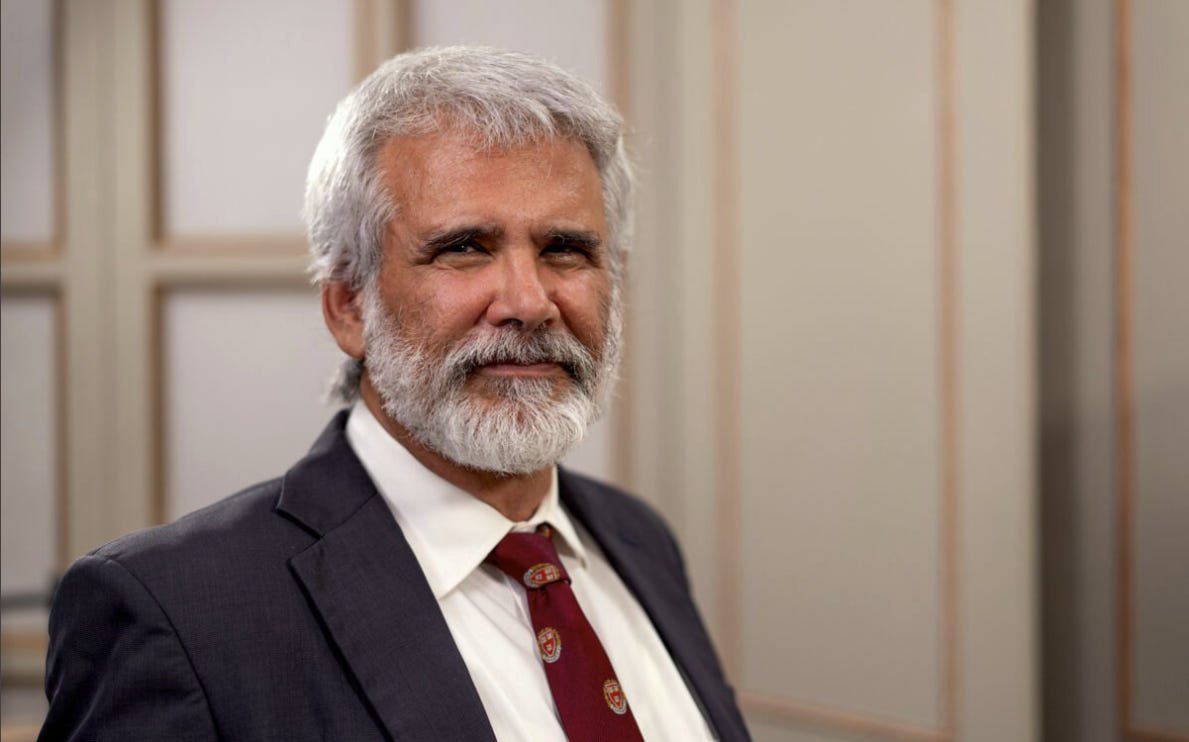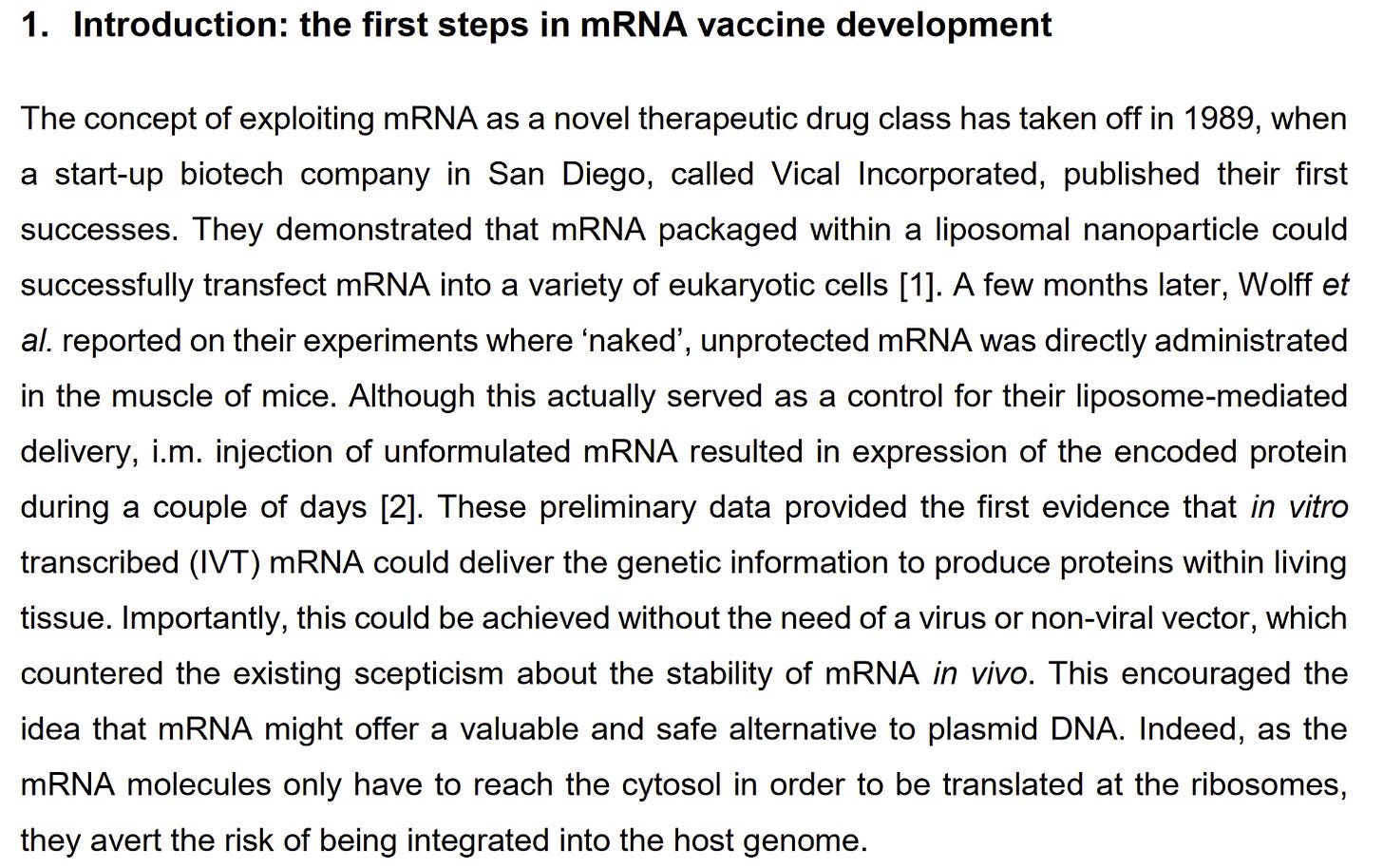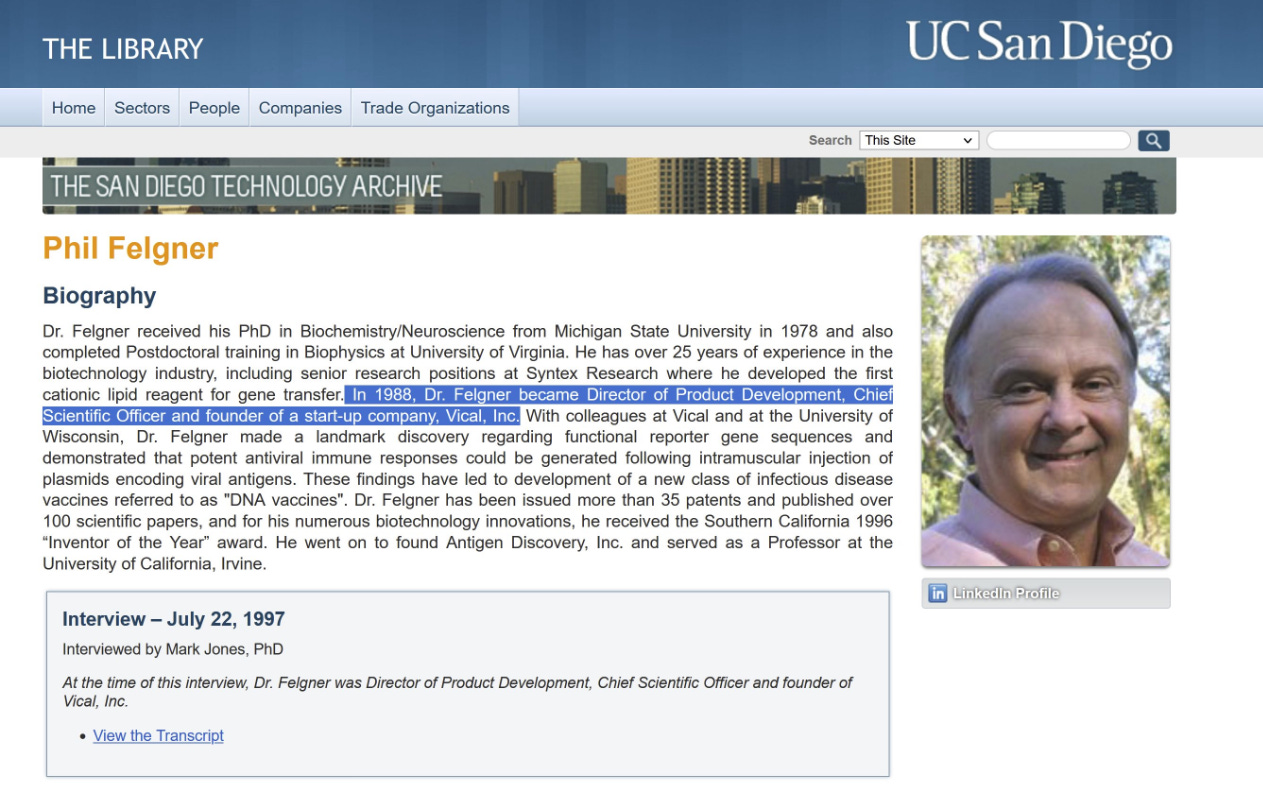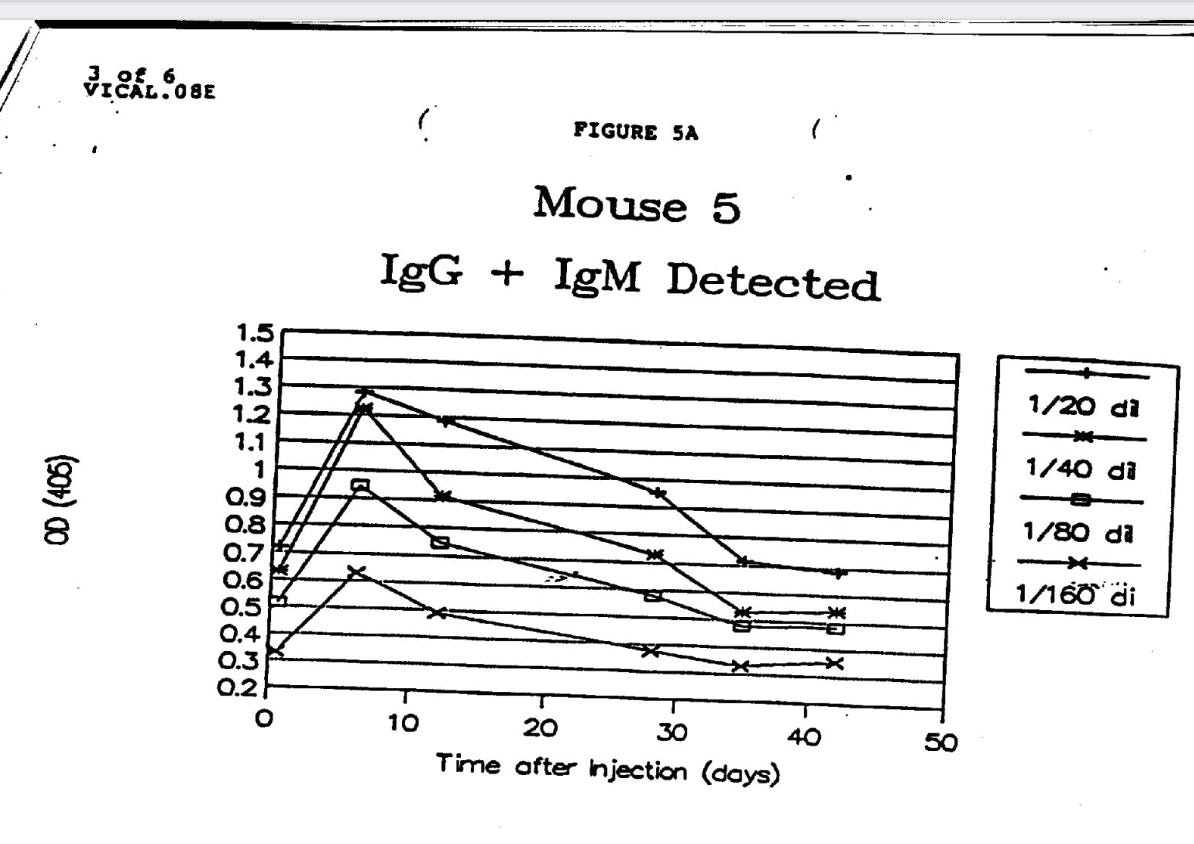Did Robert Malone invent mRNA vaccines? This article will answer—from first principles—a question that comes up surprisingly often in pandemic-related conversations.
As always, I'll give you the primary sources along with my reasoning, so you can take my answer apart and put yours together.
My investigation started with a fairly messy but fascinating thread:


This article will clean up those findings, and we'll focus on the claim as seen on Dr. Malone's (now suspended) Twitter profile: "Inventor of mRNA vaccines.”
How do we know who invented anything?
To get there, first we need to define what it means to invent something. After all, battles over who the "real" inventors of something are have sometimes carried on for decades.
So, to put some guardrails in place, the inventor of something doesn't have to be the one who invented its current form. We don't question the Wright Brothers' invention of the airplane on the basis that they didn't invent the Boeing 747.
Similarly, Google readily identifies the inventor of the electric toaster as Alan MacMasters, even though what he invented looks like a cross between a fire hazard and a torture instrument—and it only toasted bread on one side at a time.
What we're interested in is the person who did what Peter Thiel calls the "Zero to One" step. Future iterations may go from one to infinity, and are worthy of praise, but the inventor is the one who made something where nothing was before—the discontinuous step.
The history of mRNA vaccines
With this frame in mind, let's try to locate the history of the technology. I will use this well-cited paper from 2019 as my reference, as it is recent enough to be current but old enough to be untouched by pandemic drama.
Their first paragraph positions the introduction of the technology to a San Diego biotech startup called Vical:
They even give us a pretty timeline. One thing that stands out is that the work of Vical is isolated in time from other groups, with the next paper in the timeline being published three years later. It really does seem that the work at Vical is where things started.
A more current reference some use is this article from Stat. They seem to identify the earliest steps at the University of Wisconsin. Others still pinpoint the Salk Institute as the birthplace of the technology. What is going on?
Well, if we follow the first link from the original review paper, we end up with this page in PNAS, attributing the paper to the Salk Institute:
If we dig for the original paper, however, something fascinating shows up. The affiliation of the 1st author (Malone) is with three institutions, while author #2 and author #3 are in one institution each, shared only with Malone:
This is very unusual in a publication.
The obvious explanation is this work is primarily Malone's, and he's crediting two supervisors at the two institutions at which parts of the work was conducted: Felgner at Vical, and Verma at Salk. This practice is well-understood by anyone who's published in modern academia.
Supervisors almost always get their names in their reports' publications. This doesn't mean that they did (or didn't) do the work. It's a sad part of academia that your life essentially depends on your supervisor, so it is "tradition" that you put their name in your publications.
However, this particular publication—showing a cross-institutional trail, as Malone moved from Salk to Vical the same year as this publication (1989)—makes it far less likely the work was supervisor-heavy. Subordinates don't carry their supervisors' projects across positions.
The Stat article points to a 1990 paper and credits it to the University of Wisconsin. Indeed, if we look at the paper in a modern catalog, this seems to be borne out:
Similarly to the previous paper, however, if we go to the original, there's far more subtlety to work through: Malone and Felgner were credited as working at Vical. To credit this paper as purely the work of University of Wisconsin researchers doesn't seem accurate.
What's happening? Putting on my "IT systems architect" hat, I will wager a guess that whatever database migrations have happened to get these old papers online have passed through systems that have room for only one affiliated institution, with the result we see here.
Only one institution is named, the first one named for the first author. Everything else is cut off, only to be found by looking at the original papers themselves. It is very likely that this accident of history has confused not a few journalists reporting on this question.
To strip out much of the noise in this second paper, the authorship structure is as follows:
Author 1 - UW (Wolff)
Author 2 - Vical (Malone)
Author 3 - UW
Author 4 - UW
Author 5 - UW
Author 6 - UW
Author 7 - Vical (Felgner)
This looks like a clear sharing of authorship between UW and Vical, with UW taking the lead. Dr. Malone replied to my original thread explaining how that decision was made:
What seems certain is that as the review paper cites, the backbone of the project was the Vical team. Given that all the work must have been done while Malone was there, how long was his stay at Vical? His account is that it was from January '89 to August '89.
It does raise some eyebrows then, that this 1990 article from the LA Times about the work, mentions Malone only once, and in the form of a footnote.
The article does contain some fascinating history, though. Theodore Friedmann, at UCSD, was working on a different technique using viruses. One of the Assistant Professors in his lab magically showed up with a blockbuster paper using a different method. How long was he working on it?
In this article, Wolff clearly states that his involvement in the field was driven by the research contract with Vical, which begun in January 1989. The team at UW, by their own admission, did not originate the work, confirming Malone.
The story from Malone's side is documented by his wife, Dr. Jill Glasspool-Malone. We won't rely on this document much for obvious reasons, but it does plug in some important holes and fits with what we've already found out:
This second quote might go some way towards explaining why, in 1990, Vical staff (particularly Felgner) appeared to not really recognize their most prominent author in the two most relevant publications.
The only other common thread is Felgner. However, something interesting that is obvious in the record is that Vical—despite early promise—did not continue this research beyond some tweaking of the core idea. It then sold the patents to Merck, who also didn't extend the work.
In a later public filing, however, it seems clear that the purchase by Merck was to develop vaccines for humans. Whatever technology was described in the Vical patents, it was a technology that Merck thought was ready to move to human applications:
The Felgner Factor
Going back to Felgner, he seems to be—in recent years—claiming to have been one of the founders of Vical:
However, Dr. Malone questioned this claim in my original thread. Upon digging into this, the claim doesn't seem to match what is part of the public record. Vical was founded the year before Felgner joined, and it lists four founders, none of whom is Felgner.
Another fascinating hint is that the woman many claim is the true inventor of the technology, Dr. Katalin Karikó, acknowledges Dr. Malone in her 1998 publication on the topic. This doesn't help Felgner's case for being the driving force behind the invention.
What we have so far is a burst of progress around 1989, centered around the Salk Institute & Vical—starting as Malone joins Vical, stopping pretty much right after Malone departs—with the patents sold off to Merck.
Felgner also seems to have a history of claiming others' credit.
Did Vical have a vaccine?
But what did the Vical team actually invent? Malone has shared the first experimental data delivered to USPTO already in March 1990 showing immunity generated in mice by the Vical team. It's a vaccine, proven working in mammals.
At the same time, some of the documents on Malone's website point to patent applications filed via Salk Institute at the same time, describing technology that sounds incredibly familiar these days:
In the original thread that led to this article, user @reasonedscience dug up the exact part of the 1989 patent that shows the work on immunizing mammals (mice) against HIV by Malone & Co:


And this is the actual patent, which came from that excerpt:


Cleaning up the IP
Moving on, some of the notes that Dr. Malone has put up on his website date all the way back to 1988, the days he was at Salk. So, if work started at Salk, and continued at Vical—as the publications indicate and the materials shared by Dr. Malone confirm—how did the transfer of the work happen? A fascinating meeting summary is also shared by Dr. Malone:
The document seems to discuss five parties: Vical, Syntex, WARF, Salk, and UCSD: a lot of content for something this short. Syntex is Felgner's former employer, WARF is the representative of University of Wisconsin (employer of Wolff), Salk is the former employer of Malone.
Malone's supervisor at Salk was Inder Verma, mentioned here as "Inder.” The “Karl” and “Doug” mentioned are two of the founders of Vical. UCSD is another institution with which Malone was affiliated. This document shows Vical consolidating its control of the IP.
On the one hand, they expect that their payments to Wolff/UW as well as documentation of phone calls should protect them from claims from that side, while on the other side discussing licensing Salk IP, and offering Dr. Verma an advisory position at Vical. Once cleared, they seem to be planning a presentation to the Board of Directors and the company's scientific advisors. Running a startup myself, this looks like a reasonably familiar set of steps a company would take if they had a valuable asset. More importantly, the involvement of Salk lends more credence to Malone's claim that he carried over the work from Salk, and that it wasn't something that simply sprung up in a few months at Vical (which was implausible to begin with).
What about Syntex though? Did Felgner perhaps bring the the technology from there?
Another document from 1988 shared by Malone sheds light here. It's a note sent from Malone to Felgner describing Malone's work with Felgner's lipids, as well as sharing some hints as to why Felgner's earlier attempts to transfer mRNA may have failed.
Dr. Malone also shares another 1989 publication—credited only to himself—which appears to describe—for the most part—the work done at Verma's lab at Salk, published after he left Vical. Google Scholar knows of this publication, but doesn't give a link.
Pulling it all together
So where does this review of evidence leave us? We see a clear line from Salk to Vical, a proof of concept, and then a trail running cold until it's picked up again later by Katalin Karikó, until its eventual application to humans.
And so we're left with a question of semantics. If the original work by Malone and collaborators at Salk and Vical bring the work up to the level of proving efficacy on mice, and the subsequent work by others brought it to be used in humans, who invented the technology?
I think by the frame we set early on, the answer is clear: just because the Wright Brothers' first flight in the Kitty Hawk crossed a distance shorter than the wingspan of a modern 747, that doesn't mean that the inventors of the 747 can claim they invented the airplane.
Similarly, the work that brings us to having a working vaccine in humans is worthy of praise, but given that they incremented off of prior work that worked in mice, the "zero to one" designation has to go to the work that proved the concept in mice.
The Vical team also submitted six patents for this work, starting in 1989, crediting familiar names:
In the patents, we can clearly see the work done in mice, as well as the results of induced protective immune response. In my eyes, the question of whether Dr. Malone has earned the right to call himself "inventor of mRNA vaccines," would not be controversial in normal times.
There may be quibbles about apportioning of credit to different collaborators in the early work, but that's not what we're seeing. Journalists today shift the entire conversation to "who invented mRNA vaccines for humans," which is a completely different question.
Worse, some journalists distort Dr. Malone's claim to be "inventor of the currently in use mRNA vaccines for COVID-19.” This kind of alteration can only be understood as extreme incompetence or malice. In any case, nobody can take an article framing things that way too seriously.
There are a lot more threads that can be chased down regarding this question. I hope I've kept my promise from the top of this thread: I've given you links to original material, and my reasoning as to why Dr. Malone's claim is at the very least legitimate and reasonable.
I look forward to your feedback, and I will append any interesting additions that inevitably will emerge to the end of this thread. Thank you for reading this far!
PS: Ah, our first footnote! @KimJone04052805 asks whether @luigi_warren is part of the story here. In my understanding, Luigi Warren made mRNA reprogramming breakthroughs that led to the early IP that launched Moderna.
For once, the story here is clear, so let's take it straight from Luigi's mouth. He seems to confirm the conclusions we reached in this thread:

PS2: If you're interested Dr. Malone's views on what is going on with the pandemic, who should get vaccinated, and what the way forward is, I wrote up a portion of an interview he did close to the time of the original thread. It's some of the most concise, incisive thinking I've come across:


































As an ordinary, unscientifically-inclined person trying to make sense of anything to do with our apparently interminable Plague Era, I appreciate everyone with the gifts to credibly explain everything, or as much about everything as can possibly be hoped for.
And sometimes, without the right skillset, one can still go with one's gut in determining who might be a trustworthy guide and who might be just howling for attention.
I trust Boriquagato, I trust Eugyppius, I trust Igor Chudov, I trust you, and I've been strongly inclined to trust Dr. Robert Malone too, and you've done a fine service here. (I used to trust Berenson but his neuroses are overwhelming, and anyone who uses as many CAPS and exclamation points as Steve Hirsch gets put in my discard file eventually.)
Thank you.
Thank you so much for putting this together. One of the most annoying problems trying to reason with people is that they have been brainwashed that Malone is lying about being the initial progenitor of the mRNA platform. This is an evergreen resource to show people to decisively refute top to bottom.